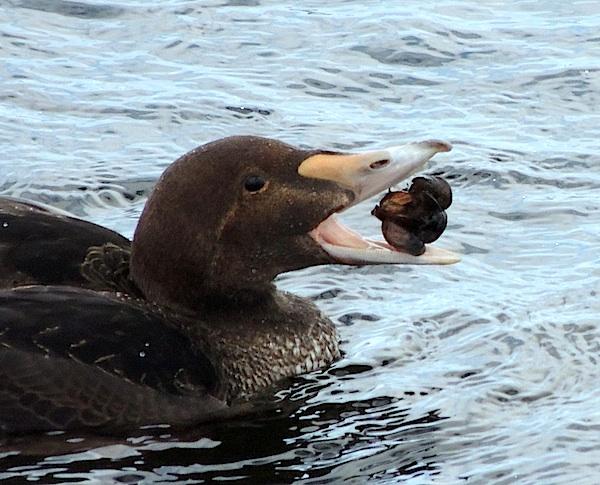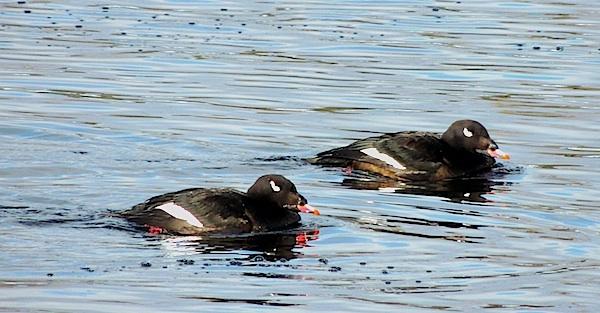
Bivalves are a tasty meal for King Eiders/Kirby Adams
I'm presuming no one needs me to tell them that Florida is a good travel and birding destination in the winter. Looking out my window at the first sticking snow of the winter is making me think about the Everglades. Winter is the dry season there, and the dwindling seasonal wetlands concentrate birds and wildlife for easier viewing.
But there's something to be said for boots, gloves, thermal underwear, and hand-warmers. We're heading into the season when some great birding can be had in the admittedly not-so-pleasant weather on our northern coasts. The beaches of Cape Cod National Seashore aren't for the faint-of-heart in December. The Piping Plovers have long ago flown south for the winter, and you won't find swim-suited families frolicking in the waves.
What you may find are bundled-up birders with scopes and binoculars scanning the water. Winter is the season of waterfowl, alcids, and gulls off the Atlantic coast. The ducks include some of the largest and oddest of the diving waterfowl. Common Eiders are huge ducks, somewhat longer and twice the bulk of a Mallard. Breeding on high arctic coastlines and down the Atlantic Coast as far as Acadia National Park (where spots on the Schoodic Peninsula offer great views), they're winter residents off the coast all the way to Cape May, New Jersey. They also periodically show up as far south as the tip of Florida, but the north is where you'll get the best views of floating flocks of eiders.
Look carefully, there just might be a rarer King Eider in the mix! Joining the eiders off of Cape Cod will be the scoters, perhaps the strangest looking ducks. With large, oddly-shaped bills designed to pluck bivalves, the scoters don't win many beauty contests, but put on quite a show during fall migration along the Atlantic Coast when tens of thousands of them can pass by in a day.
By the time winter sets in as far north as Cape Cod, there are usually a few scoters, often the common White-winged Scoter still lingering. Northern Gannets are another migratory species that heads for the Gulf of Mexico and warmer climes in fall, but tends to leave some stragglers behind. The relatives of the famous Blue-footed Booby are huge diving birds that nest on cliffside colonies in Quebec and Newfoundland, then spend the winter leisurely floating offshore further south.
Gannets are a regular December sighting off of Massachusetts shorelines. Gulls, of course, are a year-round fixture on the coast, but winter brings some new visitors like Black-legged Kittiwake, Iceland Gull, and Glaucous Gull. It's also the time of year to keep eyes and scopes open for western rarities such as Mew Gull and Slaty-backed Gull. Identifying sub-adult gulls is challenging at any time, and can be particularly vexing in a biting December wind on a cape, but a nifty reward is often awaiting those with the fortitude to scan through flocks of gulls to find the one thing that isn't like the others.

The real treats of winter birding in New England are the alcids ' puffins and their kin. While the popular Atlantic Puffin isn't a common site from shore, Razorbills, Black guillemots, and Dovekies are frequent sightings. The Dovekie is the reason many birders head to the coast in winter. Dovekies are tiny alcids, shaped much like the Razorbills and murres, but remarkably small. They're noticeably smaller than a robin, although they weigh more than twice as much. A rare sight away from Greenland and Svalbard in the summer, they spend winters along the coast from Newfoundland to Virginia.
One other bird that is starting to become synonymous with winter in the eastern United States is the Snowy Owl. Snowies have irrupted in two of the last three winters, and early indications point to a remarkable third in four years invasion of them again this winter. If so, the beaches of the all the seashores from Cape Cod to Cape Hatteras will be prime Snowy Owl hangout.
'¨'¨Got family in Boston? Have some winter outdoor gear that needs a workout. Pop out to Cape Cod and take a look at the beaches. You're guaranteed to be chilly, but a Snowy Owl, flock of eiders, and a few Dovekies is enough to warm any birder's heart.



Add comment